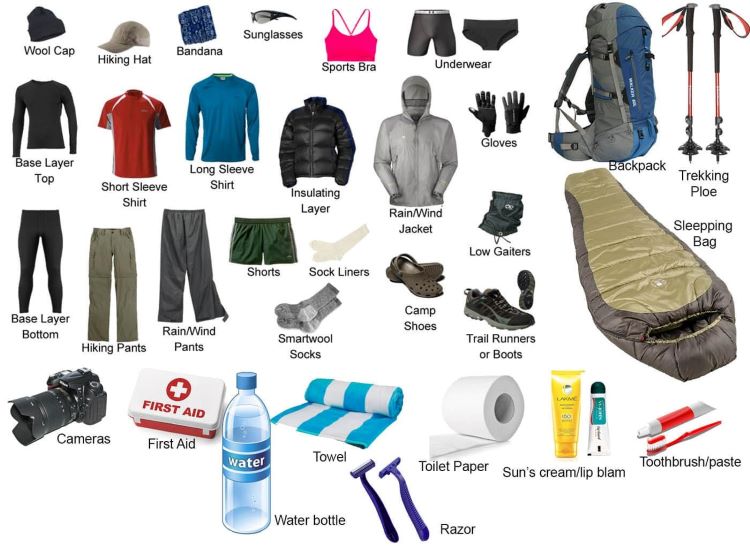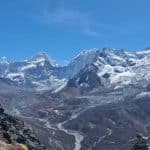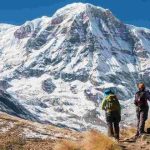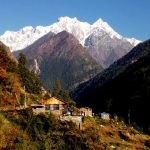Packing List for Short Treks in Nepal

When preparing for trekking in Nepal at altitudes ranging from 2500 to 4000 meters, it’s crucial to pack wisely to ensure comfort, safety, and enjoyment throughout your journey. Below is a suggested packing list tailored for popular Short treks In Nepal ( from day 4 to day 7) such as the Annapurna Base Camp, Mardi Himal Trek, Poon Hill, Langtang Trek , Pikey Peak, and other treks below 4000 meters:
Firstly, sturdy and comfortable trekking boots are a must, providing ankle support and traction on varied terrain. Layered clothing suitable for both warm days and chilly nights is advisable, including moisture-wicking base layers, insulating mid-layers, and a waterproof outer shell to protect against unpredictable weather.
Carrying a well-fitted backpack with essentials such as a water bottle, sunscreen, and a first-aid kit is essential. Trekking poles can also aid in stability and reduce strain, especially on steep ascents and descents.
Given the remoteness of some parts of the trek, a reliable sleeping bag rated for cold temperatures and a lightweight tent are often necessary unless staying in tea houses along the route. Additionally, a headlamp or flashlight is indispensable for navigating trails after dark or in low-light conditions.
Lastly, electronic gadgets such as a camera or smartphone for capturing stunning vistas, along with extra batteries or portable chargers, are recommended for documenting memories and staying connected when possible.
Packing List for Nepal Short Trekking (For 4 to 7 days Treks)
BAG / RUCKSACK
- Rucksack or Duffel Bag (35-45 liters): Essential for porters to carry all trekking gear.
- Day Pack (20-25 liters): Carry personal valuables like money, camera, and passport.
- Rain Cover / Bag Cover: Protect gear from mountain weather conditions.
- Plastic Bags: Useful for protecting valuables from rain or water.
FOOTWEAR
- Hiking Shoes / Trekking Boots: Waterproof with ankle support.
- Camp Shoes: Lightweight and comfortable (sandals or sneakers).
- Hiking Socks: 4 pairs of wool or synthetic socks (2-3 for hiking, 1 for lodge).
CLOTHING
- Thermal Layers: Essential above 3000 meters; consider for late autumn and winter.
- Down Jacket: Morning and evening warmth, especially useful for climbing Jyanjin Ri.
- Fleece Jacket: Provides warmth during breaks and tea stops.
- Waterproof Jacket and Trousers: Necessary for cold, windy conditions and occasional rain/snow.
- Hiking Trousers: Long for high altitudes, shorts for lower altitude walks.
- T-Shirts: 1-2 for daytime walking in lower altitudes.
- Trekking Shirts: Long-sleeved, breathable fabric.
- Woolen Hat: Fleece or wool beanie for warmth.
- Gloves: Lightweight and warm, waterproof gloves/mittens.
- Gaiters: Recommended for high passes and snowy/muddy trails.
- Underwear: Comfortable, moisture-wicking.
GEAR
- Sleeping Bag and Liner: Warmth is crucial for rest; aim for -20°C or above in autumn, 10°C in spring.
- Trekking Poles: Useful for stability, especially on snowy or muddy terrain.
- Aluminum Water Bottle: Insulated or with purification tablets/filters.
- Headlamp: Essential for areas with limited electricity or early morning hikes.
ACCESSORIES
- Sunglasses: UV protection with side shields.
- Sun Hat: Protects face from direct sunlight.
- Crampons: Necessary for high pass trekking on ice and snow.
- Camera: Bring extra batteries or a charger.
- Power Socket / Battery Charger: Multi-use power socket and camera battery charger.
- Toiletries: bathingTowel, soap/shampoo, hair comb, tooth brush, tooth paste
- Personal First-Aid Kit: Includes blister treatment, pain relievers, and personal medications.
- Lip Balm and Sunscreen: Protects lips and skin from cold, wind, and sun exposure.
This packing list will ensure you’re prepared for the varying conditions and terrain typical of low-altitude trekking in Nepal. Adjustments can be made based on specific trekking routes, seasonal considerations, and personal preferences.
Our Top Offer
Why booking with us ?
- Fully Locally Owned Company
- Quality Of Service and Competitive price
- Highly Professional Staff
- Flexible and customization trip itinerary
- 100% Customer satisfaction
Need help?
Nepal: 00977-9841273869 whatsapp: 00977-984127386924 hour customer service




